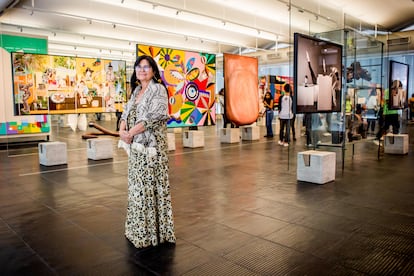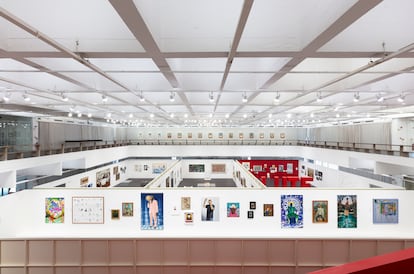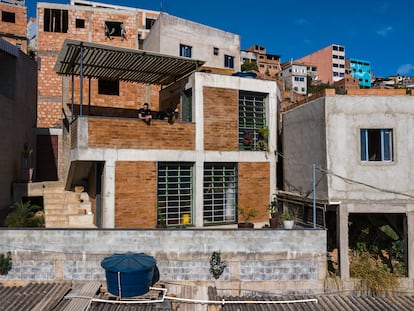In this Brazilian museum, women, Indigenous people and those of African descent are going to have the last word
While the debate about the decolonization of museums has recently picked up steam, the São Paulo Museum of Art has already spent almost a decade giving prominence to indigenous and Afro-Brazilian art, putting it ahead of the work by painters like Gauguin or Van Gogh

The São Paulo Museum of Art (MASP) is considered to be the center of Western art in Brazil, or the institution with the most important collection of European art in South America. At least, it was, until 2014, when Adriano Pedrosa was appointed the artistic director.
Before Pedrosa took over as curator, the history of art at the MASP was told from the perspective of Modigliani, Van Gogh, Picasso and Gauguin, who had a combined total of 13 pieces on display. They represented the official version of art history: white, male and colonial. But nine years ago, Indigenous people, Afro-Brazilians and women took center stage. Long before restoration and decolonization became a trend in the art world, the MASP had already opened the debate.
“This museum is diverse, inclusive and plural… [it] has the mission of establishing, critically and creatively, dialogues between past and present, cultures and territories, based on the visual arts,” reads a poster.
Upon reaching the second floor – where the permanent collection is displayed – this objective is confirmed. The first paintings you see represent the feminist struggle, Brazilians of African descent, as well as various handicrafts rescued from Europe, which are the creations of the native population of Brazil.
All of these pieces of contemporary art have been acquired by the MASP over the last decade. In a collection where classic European men once ruled, they have changed the atmosphere. The 200 exhibited works by European painters are now displayed in the middle and towards the end of the MASP’s collection, rather than at the start.
The classical European pieces were largely acquired by Pietro Maria Bardi, a collector, journalist and art dealer of Italian origin. In the 1940s, after World War II, he began to buy works by great European artists “at a discounted price.” For instance, Bardi paid $40,000 for Van Gogh’s Student and Velázquez’s The Portrait of Count-Duke de Olivares. At the end of the 1990s, when Bardi passed away, these two paintings were valued at an astonishing $30 million. Another large part of the museum’s holdings comes from collections of European Jews who fled Nazism on their way to the Americas.

All the pieces are displayed on large methacrylate panels, which are affixed to cement blocks. These displayed structures were created by Lina Bo Bardi, the architect who designed the building in 1947. These kinds of large frames were recovered in 2015, with the original intention of their creator: to question the traditional European museum model. Instead of everything being hung on walls, the art in the MASP is suspended in the air, mobile and malleable. This format also permits the collection to be easily reorganized every two weeks; visitors get to take a different path each time.
The MASP rewrites the history of art starting with the artists… but it also blows up linear museology. It doesn’t follow a chronological route to the letter, either: it begins with the present towards the “whiter” past, with creative license.
The transparent frames have another function: they allow you to see the back of the paintings, which have all the information that traditional museums don’t show, as the pieces tend to hang on the walls. And it is there, at the rear, where Pedrosa – following Bardi’s guidelines – has placed the informative inscriptions.
The three-dimensional effect that MASP intends to achieve is as follows: two figures representing the devil in African culture are exhibited in a showcase. The glass allows you to see, in the background, the painting Pink and Blue - The Cahen d’Anvers Girls, by Renoir, where two smiling little girls are represented. One of them died at Auschwitz.
The visitor will first see the African pieces; behind them, the impressionist painting. Then, you will be able to slip behind it and read all the information. In the end, the viewer ends up with another version of the story.

The museum will, once again, invite you to reflect on two different pieces placed in another position. One is an idealized version of the death of an Indigenous woman, by Victor Meirelles. Next to it is a critical perspective of the artist and activist Denilson Baniwa, with a collage that represents the deforestation of the Amazon. Baniwa has placed the silhouette of a murdered Indigenous person in the piece, as if it were a crime scene.
The museum has dedicated the year 2023 to Indigenous stories, while 2024 will be devoted to sexual diversity. As Pedrosa notes in an interview with EL PAÍS, the museum has hosted Indigenous art in its rooms in both individual and collective exhibitions.
During the upcoming exhibition, one of the two paintings by Gauguin from the MASP – which represents the Indigenous women of Tahiti – will stop hanging in the main room for a few weeks. As part of the exhibition, the museum wishes to criticize the colonial vision that the French painter had of these communities.
Those who are rethinking these old perspectives are the three Indigenous curators at MASP, who became part of the institution in 2022. The appointment of the trio reflects the growing strength and relevance of Indigenous art in museums, galleries and fairs in Brazil. The last São Paulo Biennial – held in 2021 – took special care to invite them and give them a prominent role. The MASP, however, took that step long before, in an attempt to maintain a more fluid dialogue with its compatriots… not just with the so-called great masters.

Sign up for our weekly newsletter to get more English-language news coverage from EL PAÍS USA Edition
Tu suscripción se está usando en otro dispositivo
¿Quieres añadir otro usuario a tu suscripción?
Si continúas leyendo en este dispositivo, no se podrá leer en el otro.
FlechaTu suscripción se está usando en otro dispositivo y solo puedes acceder a EL PAÍS desde un dispositivo a la vez.
Si quieres compartir tu cuenta, cambia tu suscripción a la modalidad Premium, así podrás añadir otro usuario. Cada uno accederá con su propia cuenta de email, lo que os permitirá personalizar vuestra experiencia en EL PAÍS.
¿Tienes una suscripción de empresa? Accede aquí para contratar más cuentas.
En el caso de no saber quién está usando tu cuenta, te recomendamos cambiar tu contraseña aquí.
Si decides continuar compartiendo tu cuenta, este mensaje se mostrará en tu dispositivo y en el de la otra persona que está usando tu cuenta de forma indefinida, afectando a tu experiencia de lectura. Puedes consultar aquí los términos y condiciones de la suscripción digital.
More information
Archived In
Últimas noticias
Welcome to the post-religion era: The idea of Christianity as the absolute truth has become obsolete
‘I thought you would like it’: The risky sexual practice popularized by TV shows and TikTok
The digitalization of tourism: ‘They promise experiences and gave us the worst possible one’
Mexican peso defies uncertainty with forecasts of a new period of stability in 2026
Most viewed
- Sinaloa Cartel war is taking its toll on Los Chapitos
- Reinhard Genzel, Nobel laureate in physics: ‘One-minute videos will never give you the truth’
- Oona Chaplin: ‘I told James Cameron that I was living in a treehouse and starting a permaculture project with a friend’
- Why the price of coffee has skyrocketed: from Brazilian plantations to specialty coffee houses
- Silver prices are going crazy: This is what’s fueling the rally










































